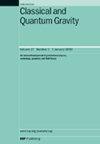暗物质湮灭的引力波印记:通过EMRI信号探测光晕结构
IF 3.7
3区 物理与天体物理
Q2 ASTRONOMY & ASTROPHYSICS
引用次数: 0
摘要
引力波(GWs)作为暗物质晕的潜在探测器,近年来备受关注。本文研究了暗物质粒子的湮灭通道(即s波、p波和d波)如何影响暗物质晕的空间分布特征,从而在极端质量比激励(EMRI)系统的GW信号上留下可观察到的印记。我们构建了包含s波、p波和d波湮灭通道的暗物质晕密度分布模型。我们将这些模型与EMRI系统的轨道演化方程相结合,推导出频域重力波形的相位修正。我们的研究表明,s波湮灭导致暗物质晕中扁平密度区域的形成,而p波和d波湮灭主要改变晕内较小尺度的结构。这些不同的暗物质晕构型导致了引力波形中显著不同的相移,为区分暗物质粒子的散射特性提供了一个新的观测窗口。未来的天基GW探测器,如LISA,有望通过精确测量EMRI系统的GW信号来提供对小尺度暗物质晕和暗物质粒子基本特性的约束。这些发现不仅为暗物质湮灭的GW特征提供了新的见解,而且对于通过伽马射线或宇宙射线观测间接探测暗物质具有潜在的意义,因为修改的光晕剖面可能会影响电磁波谱中预期的湮灭信号。本文章由计算机程序翻译,如有差异,请以英文原文为准。
Gravitational wave imprints of dark matter annihilation: probing halo structures through EMRI signals
Gravitational waves (GWs), as potential probes of dark matter halos, have received much attention recently. This paper investigates how the annihilation channels of dark matter particles—namely s-wave, p-wave, and d-wave—influence the spatial distribution characteristics of dark matter halos, thereby leaving observable imprints on the GW signals from extreme mass ratio inspiral (EMRI) systems. We construct dark matter halo density distribution models incorporating s-wave, p-wave, and d-wave annihilation channels. We derive the phase corrections to the frequency-domain gravitational waveforms by combining these models with the orbital evolution equations of EMRI systems. Our study reveals that s-wave annihilation leads to the formation of a flattened density region in the dark matter halo, while p-wave and d-wave annihilation primarily modify smaller-scale structures within the halo. These distinct dark matter halo configurations induce significantly different phase shifts in the gravitational waveforms, providing a new observational window to distinguish the scattering properties of dark matter particles. Future space-based GW detectors, such as LISA, are expected to provide constraints on small-scale dark matter halos and the fundamental properties of dark matter particles by accurately measuring the GW signal of EMRI systems. These findings not only offer new insights into the GW signatures of dark matter annihilation, but also have potential implications for indirect dark matter detection via gamma-ray or cosmic-ray observations, as the modified halo profiles may affect the expected annihilation signals in the electromagnetic spectrum.
求助全文
通过发布文献求助,成功后即可免费获取论文全文。
去求助
来源期刊

Classical and Quantum Gravity
物理-天文与天体物理
CiteScore
7.00
自引率
8.60%
发文量
301
审稿时长
2-4 weeks
期刊介绍:
Classical and Quantum Gravity is an established journal for physicists, mathematicians and cosmologists in the fields of gravitation and the theory of spacetime. The journal is now the acknowledged world leader in classical relativity and all areas of quantum gravity.
 求助内容:
求助内容: 应助结果提醒方式:
应助结果提醒方式:


